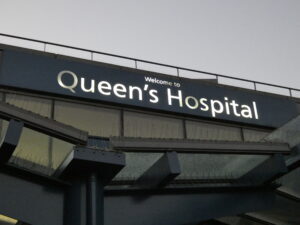
Queens Hospital
(Written by Local Democracy Reporter, Sebastian Mann)
Figures published by NHS England showed the east London trust had improved greatly in the number of patients being treated within four hours, despite the pressures it faces.
Of the 28,000 people admitted to A&E at the trust, around 21,000 – or 75% – were discharged in that timeframe.
More than 6,500 of those patients were sent to ‘type-one’ departments, which care for people most in need of urgent help. That is almost half the number of people admitted needing serious help, which totalled 12,499.
Matthew Trainer, chief executive of the trust, said: “Almost 7,000 more patients were seen and treated within four hours this February compared to [around 15,000] last year.
“This is great to see and is a testament to our clinical and operational teams.”
Steady improvement over 2023 also saw the trust jump from being one of the worst performing in the country into the top 25.
Nurses and specialists managed to keep the rate high of four-hour discharges despite 600 more ambulances bringing patients to Queen’s Hospital than in February 2023.
That increase was the largest spike in the entire capital, based on data from the health service.
However, the Romford hospital is still working far beyond its capacity.
Every day, more than 600 people go through a department designed for 300, the chief executive said.
He added: “This means too many older people are spending the night on beds in corridors, and we have lots more to do to reduce waits for everyone.”
An internal critical incident was declared at Queen’s Hospital on Tuesday, 12th March due to “bed pressures across the site”.
Staff were told to follow OPEL-4 (operational pressures escalation levels) procedures, which means the institute is “unable to deliver comprehensive care,” and non-essential meetings were stepped down.
It was in place until Friday, 15th March.
In an X (Twitter) exchange with The Sunday Times’ health editor Shaun Lintern, the chief executive said: “[We] need to make sure the improved four-hour doesn’t take focus off long waits and poor [patient] experience due to crowding.
“Six-hundred people a day into an [emergency department] built for 300 doesn’t go. Staff won’t trust us if we don’t acknowledge this.”
During the six-day junior doctor strike, between 3rd and 9th January, the trust postponed 6,000 outpatient appointments and almost 1,200 non-urgent surgeries.
Ensuring that patients are seen more quickly in emergency departments is one of the NHS’ top priorities.
It is aiming for 76% of patients being admitted, transferred, or discharged within four hours by March 2024, with further improvement in 2024/25.
As part of its two-year urgent and emergency care recovery plan, the NHS is also working to ensure ambulances get to patients quicker.
Across England, a total of 2.1million people were admitted to A&E in February.